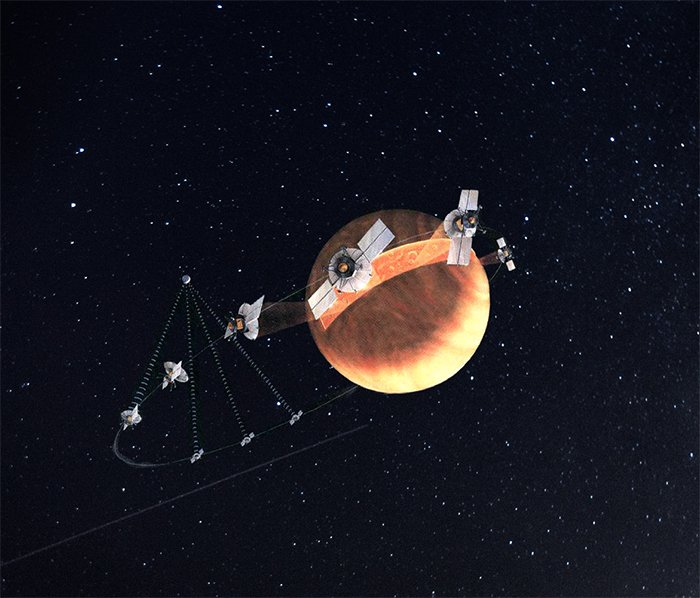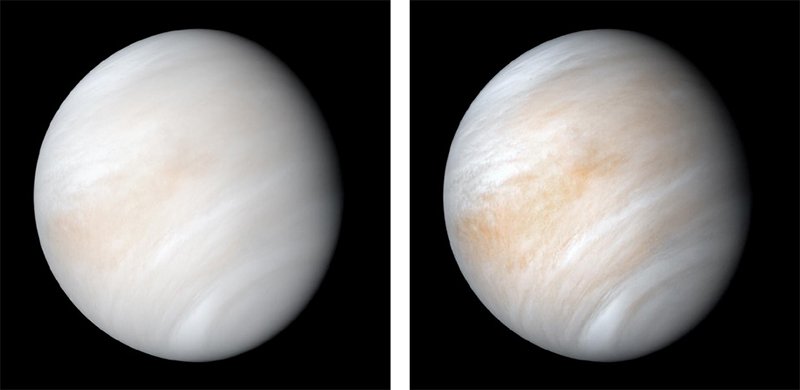Venus: Earth’s Noxious Neighbor
Despite some similarities, Earth and the planet next door have very different purposes.
Earth revolves around the sun in a galactic neighborhood of eight planets. We are third from the sun. On one side of Earth orbits Mars, planet number four. Thanks to media attention and Hollywood thrillers, we’re familiar with this neighbor. In fact, if Elon Musk deploys his ambitious plan, humans might step foot on the red planet by 2026.
As the reaches of our space exploration expand, much is said about what makes a planet inhabitable—distance from the sun, presence of water, hospitable atmosphere—but for a master class in what makes a planet uninhabitable, look no farther than Earth’s other next-door neighbor.
On the side of Earth, closer to the sun, looms Venus, the mysterious planet that shows up in the early morning or early evening skies as a pinprick of light brighter than any of the other planets and stars.
Astronomers know Venus as more than just a neighbor. They call it Earth’s twin. The size, mass, and density (called gross properties) of Venus and Earth are more similar than any other pair of planets. Yet if Venus is Earth’s twin, it is most certainly the evil twin. Despite their similar gross properties, the two planets could not be more different.
A far cry from the temperate blue marble Earth, dripping with water and flourishing with every imaginable kind of life, Venus is a rust-colored, barren orb whose surface is textured with mountains, including a seven-mile-high (11 km) summit—that’s two miles higher than Mount Everest—and volcanoes. Even its clouds consist of sulfuric acid, making the entire place reek of rotten eggs. The atmospheric pressure on Venus’ surface is approximately 93 times that of Earth’s—the same pressure as 3,000 feet (914 m) beneath the ocean’s surface.

Venus’ surface was first mapped by the Magellan orbiter between 1990–1991. During three visits, the Magellan transmitted images back to Earth.
At 900°F (482°C), the surface temperature burns right past even Mercury, the planet closest to the sun. With that heat, Venus offers no warm welcome to visitors. In the 1980s, a Russian lander that touched down on Venus’ surface survived for only two hours before succumbing to the planet’s hostile environment.

Photos by NASA/JPL
Before the Magellan images, the best photo of the mysterious planet (left) was captured by Mariner 10 in 1974. Newly processed using modern software (right), the image shows Venus’ thick cloud cover in greater detail.
According to evolutionary models, both Venus and Earth formed around 4.5 billion years ago when the solar system was nothing more than a swirling cloud of dust and gas. First, gravity pressed the dust and gas together into a spinning mass to form the sun. The rest of the dust and gas gathered to form the planets. Since Venus and Earth are at a similar distance from the sun, most astronomers think that their histories ought to be similar.
In 2021, NASA announced two upcoming probe visits to Venus, launching between 2028 and 2030. These will be the first US-led missions to Venus’ atmosphere since 1978. One probe will map Venus’ surface, searching for evidence of plate tectonics and active volcanoes. The other probe will study Venus’ atmosphere, looking for clues of how the planet formed and if it ever hosted an ocean.
“Only Venus can tell us why our home planet is unique in our solar system and the likelihood of actually finding Earth 2.0 around another star.”
But what’s behind this growing interest in our forbidding neighboring planet? NASA planetary geophysicist Sue Smrekar said, “Only Venus can tell us why our home planet is unique in our solar system and the likelihood of actually finding Earth 2.0 around another star.” Evolutionary scientists hope to understand, if the twin planets started out similar, why Venus ended up the apocalyptic place it is today while Earth is, well, our home.
Once Upon a Long, Long Time Ago . . .
Carbon dioxide makes up 96% of Venus’ thick atmosphere. Nearly half the sunlight passes through the cloudy atmosphere to heat the planet’s surface, but the huge amount of carbon dioxide traps the heat, raising Venus’ surface temperature to hellish levels. Some of this heat eventually flows to the top of the atmosphere, where it radiates into space, establishing a constant, high temperature on the Venusian surface.
Yet evolutionists believe Venus might have once looked much like Earth today. At one point, they think, Venus might have had a little more curb appeal, possibly with oceans and a kinder temperature. Maybe, in a brief billion-year window, life might have evolved on Venus. But then Venus let itself go.
The evolutionary model requires that in the early solar system almost 4.5 billion years ago, the sun was nearly 40% fainter than it is today. But this presents a problem for the Earth. With a fainter sun, if all else were the same, Earth would have ended up an ice world, a condition from which our planet probably could not have recovered. Astronomers call this the faint young sun “paradox.” So how do evolutionists explain why Earth remains inhabitable today? Their most common solution is that the early Earth had more greenhouse gases than it has today.
They hypothesize that much carbon dioxide was tied up in rocks inside both Earth and Venus. The volcanic activity would have released some of this carbon dioxide into the atmosphere. Carbon dioxide dissolves in water, and the dissolved carbon dioxide can precipitate out to form carbonate rocks on the floors of oceans, removing carbon dioxide from the atmosphere. However, the amount of carbon dioxide that can dissolve in water is dependent upon the water’s temperature. Cooler water can accommodate more carbon dioxide. Therefore, since Earth is farther from the sun, its oceans were probably cooler than oceans on Venus. So Earth was more efficient than Venus in removing carbon dioxide from its atmosphere as volcanic activity introduced carbon dioxide into the air. Ideally, the introduction of carbon dioxide into the atmosphere is balanced by its removal, resulting in a constant amount of atmospheric carbon dioxide. When it evolved on Earth, marine life aided in removing the carbon dioxide from Earth’s atmosphere. At least, this is what is thought to have happened on Earth.
A Cautionary Tale?
As the story goes, since Venus is 28% closer to the sun, it receives nearly twice the heat from the sun that Earth does. Being initially warmer than Earth, Venus’ oceans were warmer than terrestrial oceans, rendering Venus’ oceans less efficient at removing carbon dioxide from its atmosphere, which led to more heating. More heating further raised the temperature of Venus’ oceans, reducing its ability to remove carbon dioxide, which led to more carbon dioxide build-up in its atmosphere, leading to higher temperatures. This runaway greenhouse effect eventually caused Venus’ oceans to boil, and solar radiation ionized the water vapor that then escaped into space. Venus was left with a thick, carbon dioxide-based atmosphere.
But if the Earth and Venus are twins, where is the bulk of Earth’s carbon dioxide? Much carbon dioxide is locked up in Earth’s carbonate rocks, but some of the carbon dioxide is transformed into fossil fuels. Many scientists see Venus as a cautionary tale for Earthlings.
If we don’t mend our ways of spewing carbon dioxide into the atmosphere by burning fossil fuels, then Earth may go the way of Venus. It’s easy to see how a faulty view of the universe’s origin has led to the frenzied concern over man-caused global warming and climate change.
Trouble in the Neighborhood
According to spacecraft data, both Mars and Venus appear to have experienced violent upheaval—like Earth’s own upheaval during the global flood.

Image not to scale.
Venus
The surface of Venus appears to have been rapidly overturned not long ago. Evolutionists say the upheaval happened 150 million years ago—recent in the evolutionary timeline. But creationists interpret this as a catastrophe only a few thousand years ago. It is unclear whether the upheaval correlated to the fall or flood.
- Rotation
Venus rotates backward so that the sun rises in the west and sets in the east. The sun rises every 117 Earth days on Venus. - Atmosphere
Though Venus rotates slowly, its dense sulfuric atmosphere rotates 60 times faster with the top layer of clouds blown by 224 mph (360 kph) winds. - Lightning
Unlike Earth’s lightning, which shoots from electronically charged clouds of water, lighting on Venus strikes from clouds of sulfuric acid. - Storms
A cyclone storm the size of Europe constantly spins at the south pole. Uniquely, the storm has two vortices, giving it a double “eye.”
Mars
Mars appears to have experienced a worldwide or nearly worldwide flood at some point.
Earth
Flood geologists infer from the Genesis account that Earth’s global flood was accompanied by tectonic upheaval. Yet geologists who reject such a catastrophic event on Earth accept that a similar thing happened on Venus. And the same geologists who reject the possibility of a worldwide flood on Earth (a planet with abundant water) accept that Mars (a planet with no liquid water today) was once flooded.
It’s as if God caused a tectonic upheaval and a flood on these planets to show that he could have done both on Earth at the time of Noah, just as Scripture says.
Looking for Life on Venus
As recently as the late 1950s, many scientists thought that Venus might harbor life. They had noted that Venus’ surface is continually obscured with clouds. Since terrestrial clouds consist of water droplets, scientists reasoned that Venusian clouds were also made of water droplets. So much water in the atmosphere seemed to suggest that a large ocean might exist on Venus. And where water is, they thought, life forms.
But as astronomers learned about Venus’ dense carbon dioxide-laden atmosphere, in contrast to Earth’s nitrogen-rich atmosphere, they concluded that Venus’ surface temperature is blistering. Because they believe Venus was never cool enough for water vapor to condense out of its atmosphere, it probably never formed liquid water on the ground, let alone oceans of it. Astronomers also found that Venus’ clouds consist mostly of sulfuric acid, not water. Neither of these conditions boded well for life, so hope for life on Venus waned considerably.
Still, some scientists continue to think that Venus once harbored life before the supposed runaway greenhouse effect raised temperatures to a scorching level. Others think that small microbes might still exist at high altitudes in Venus’ atmosphere. This optimism has led to some premature conclusions. In September 2020, scientists announced that they had detected the gas phosphine in Venus’ atmosphere. On Earth, phosphine is found in human and animal intestines and in some microorganisms. Scientists viewed this discovery as a possible sign of life.
Other scientists proposed that the phosphine originated from volcanoes erupting to spew compounds into the atmosphere where they would mix with sulfuric acid and other elements to create phosphine. After all, if volcanoes set the stage for life on Earth by spewing materials that helped life evolve, volcanoes might even be fueling life on Venus as we speak. The problem is that they don’t know if any volcanoes are active on Venus, though they were certainly active in the past.
However, subsequent studies mistakenly suggested that perhaps scientists confused phosphine for sulfur dioxide, an abundant gas in the planet’s atmosphere. Despite much eager speculation, no indisputable proof of life has been found on Venus.
Even after so many dead ends in the search for extraterrestrial life, scientists with a naturalistic worldview still do not recognize that life does not arise wherever the conditions for life are right. Rather, the existence of life requires a Creator. Four centuries of biology has taught us the law of biogenesis: life does not arise spontaneously from nonlife.
Prepared for a Different Purpose
Secular scientists are right about one thing: Venus and Earth have the same history. But they didn’t come about by natural means from random swirling dust and gas.
Secular scientists are right about one thing: Venus and Earth have the same history. But they didn’t come about by natural means from random swirling dust and gas. Rather, both planets were spoken into existence by the Creator in the beginning.
Earth was specially prepared for our existence over six days of creation as God spread out the seas and established the land and filled both with life, including Adam and Eve.
On the other hand, Venus was created on day four of creation week with the other heavenly bodies “for signs and for seasons, and for days and years” (Genesis 1:14). Scripture doesn’t indicate that God assigned life forms on any planet or moon in the universe other than Earth. Venus would naturally be very different from Earth because it was prepared for a different purpose.
In their search for life to confirm their evolutionary assumptions, scientists miss the point. With its inhospitable conditions for life, Venus brings glory to God as the caustic and hostile place it is, emphasizing the special care that God took in creating Earth.
We needn’t worry that Earth will end up looking like Venus. Just as God created the Earth to be inhabited, he has promised to one day restore it when he recreates the new heavens and Earth. Venus, too, will get a renovation. Who knows? Maybe we’ll be able to have a neighborly visit with the planet next door.

Answers in Genesis is an apologetics ministry, dedicated to helping Christians defend their faith and proclaim the good news of Jesus Christ.
- Customer Service 800.778.3390
- Available Monday–Friday | 9 AM–5 PM ET
- © 2025 Answers in Genesis



